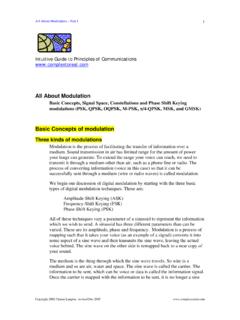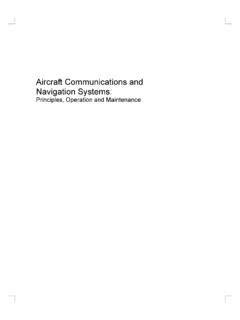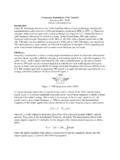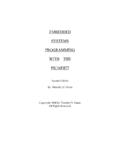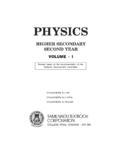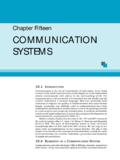Transcription of Basic Concepts of modulation - Berk
1 All About modulation Part I Copyright 2002 Charan Langton 1 Intuitive Guide to Principles of Communications All About modulation - Part I Basic Concepts , Signal Space, Constellations and Phase Shift Keying modulations (PSK, QPSK, OQPSK, M-PSK, /4-QPSK, MSK, and GMSK) Basic Concepts of modulation Three kinds of modulations modulation is the process of facilitating the transfer of information over a medium. Voice can not be sent be very far by screaming. To extend the range of sound, we need to transmit it through a medium other than air, such as a phone line or radio.
2 The process of converting information (voice in this case) so that it can be successfully sent through a medium (wire or radio waves) is called modulat ion. We begin our discussion of digital modulation by starting with the three Basic types of digital modulation techniques. These are; Amplitude-Shift Keying (ASK) Frequency-Shift Keying (FSK) Phase-Shift Keying (PSK) All of these techniques vary a parameter of a sinusoid to represent the information which we wish to send. A sinusoid has three different parameters than can be varied. These are its amplitude, phase and frequency.
3 In ASK, the amplitude of the signal is changed in response to information and all else is kept fixed. Bit 1 is transmitted by a signal of one particular amplitude. To transmit 0, we change the amplitude keeping the frequency constant. On-Off Keying (OOK) is a special form of ASK, where one of the amplitudes is zero as shown below. All About modulation Part I Copyright 2002 Charan Langton 2 Figure 1 - Baseband information sequence 0010110010 ASK ts tft() ()sin()=2 Figure 2 - Binary ASK (OOK) Carrier In FSK, we change the frequency in response to information, one particular frequency for a 1 and another frequency for a 0 as shown below for the same bit sequence as above.
4 In the example below, frequency f1 for bit 1 is higher than f2 used for the 0 bit. FSK tf tfor bitf tfor bit()sin()sin()= 212012 Figure 3 - Binary FSK Carrier In PSK, we change the phase of the sinusoidal carrier to indicate information. Phase in this context is the starting angle at which the sinusoid starts. To transmit All About modulation Part I Copyright 2002 Charan Langton 30, we shift the phase of the sinusoid by 180 . Phase shift represents the change in the state of the information in this case. sin(2)1()sin(2)0f tfor bitPSK tf tfor bit = + Figure 4 - Binary PSK Carrier (Note the 180 phase shifts at bit edges) ASK techniques are most susceptible to the effects of non-linear devices which compress and distort signal amplitude.
5 To avoid such distortion, the system must be operated in the linear range, away from the point of maximum power where most of the non-linear behavior occurs. Despite this problem in high frequency carrier systems, Amplitude Shift Keying is often used in wire-based radio signaling both with or without a carrier. ASK is also combined with PSK to create hybrid systems such as Quadrature Amplitude modulation (QAM) where both the amplitude and the phase are changed at the same time. What is digital, what is analog? There are three parts to a communications system. 1. The information, also called the baseband 2.
6 The medium 3. The carrier Information can be defined in two forms, digital or analog. Analog signal is considered continuous. Its signal amplitude can take on any number of values between the signal maximum and minimum. Voice is analog and can take any number of volume levels between its dynamic-range which is the range of volumes your vocal cords can produce. Digital devices convert analog voice to a digital signal by process of sampling and quantization. The analog signal is first sampled and then quantized in levels and then each level is converted to a binary number.
7 For example, we may quantize your voice in 16 levels. Each of these levels can be represented by four bits. All About modulation Part I Copyright 2002 Charan Langton 4 Perhaps you remember when your telephone system went to the tone dialing. It went from being a pure analog system to a digital system based on sampling and quantization. Other examples of analog information are music and voice transmitted via FM and AM radio transmissions. Nearly everything else nowadays is digital. The medium is thing the signal travels through. It can be air, space or wires of all sorts.
8 Each of these mediums offers its own unique set of advantages and distortions that determine what is used as a carrier. A short wire in a chip for example may not need a carrier at all. A signal through space such as for satellite transmission may need a very high frequency carrier that can overcome space loss and other losses. If medium is the road taken, then carrier is the truck that carries the information hence we call it Carrier. Depending on the medium, it can be light as in optical communications or a microwave signal as for mobile communications. An electromagnetic carrier can be of any frequency depending on the medium and the communication needs.
9 Most mediums dictate what type of carrier (its frequency, amplitude) can propagate through it and the type of distortions it will suffer while traveling through it. Anything that is wireless is analog always. Wired signals can be digital or analog. Communications inside a computer are examples of pure digital communications, digital data over digital medium. LAN communications are digital data over analog medium. The radios are examples of analog data over analog medium. In general when we talk about a digital system, we are usually talking about digital information over an analog medium.
10 However, there are exceptions. Pulse Coded modulation (PCM) is a form of modulation where there is no carrier, so that makes it a pure digital system. The Shift Keying the second two terms in the name of these modulations imply that they are digital modulations, the information is digital. modulation is the process by which we map information on to a carrier. How many ways can you fit your bags in car? Can you repack your stuff to make it fit better? These are the conceptual questions we tackle when we talk about modulat ion. Signal Spaces and basis functions Study of signal spaces provides us with a geometric method of conceptualizing the modulation process.

